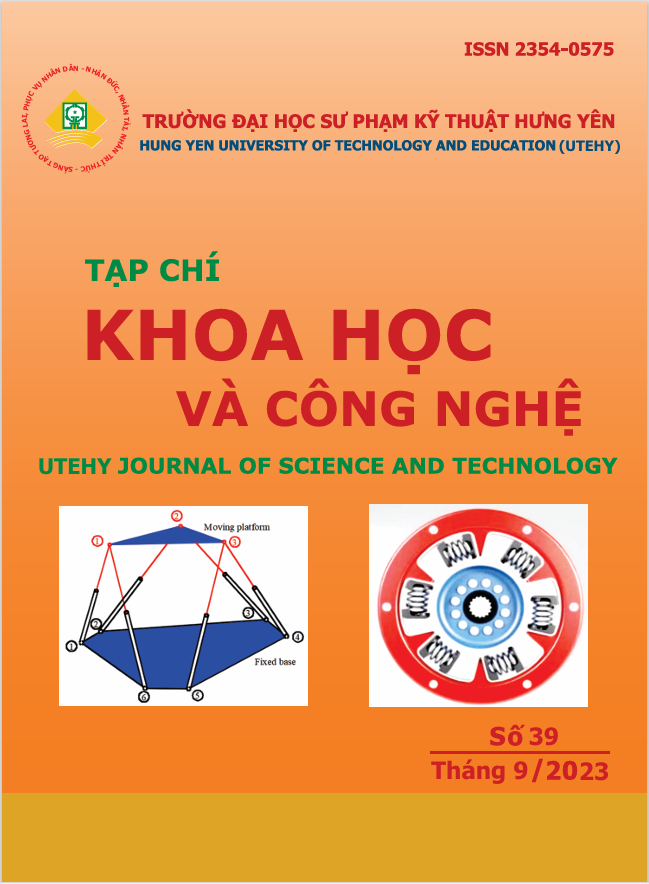SMOOTH AND TIME OPTIMIZATION TRAJECTORY PLANNING FOR ROBOTS USING POLYNOMIAL INTERPOLATION
Abstract
In this study, the trajectory planning for robots using polynomials is investigated. The polynomials used to plan the robot’s trajectory include multiple cubic polynomials, multiple quintic polynomials, and one higher-order polynomial for the entire trajectory segment with the requirement of smooth motion, i.e., maintaining continuity of velocity, acceleration, and jerk within allowable limits. The traveling time was also an optimized factor. The application results for a parallel robot show that the trajectory using multiple cubic polynomials has the shortest traveling time. However, using multiple cubic polynomials has the disadvantage of a discontinuous jerk. Using a single higher-order polynomial for the entire trajectory takes about 12 % more time than multiple cubic polynomials but has the advantage of a continuous jerk.
References
Q.-C. Pham, “Trajectory planning,” Handb. Manuf. Eng. Technol., 2015, pp. 1873-1887.
M. T. Nguyen, C. Yuan, and J. H. Huang, “Kinematic analysis of A 6-DOF robotic arm,” in Advances in Mechanism and Machine Science: Proceedings of the 15th IFToMM World Congress on Mechanism and Machine Science 15, 2019, pp. 2965-2974.
A. Gasparetto, P. Boscariol, A. Lanzutti, and R. Vidoni, “Path planning and trajectory planning algorithms: A general overview,” Motion Oper. Plan. Robot. Syst. Backgr. Pract. Approaches, 2015, pp. 3-27.
A. Visioli, “Trajectory planning of robot manipulators by using algebraic and trigonometric splines,” Robotica, 2000, vol. 18, no. 6, pp. 611-631.
Y. Li, T. Huang, and D. G. Chetwynd, “An approach for smooth trajectory planning of high-speed pick-and-place parallel robots using quintic B-splines,” Mech. Mach. Theory, 2018, vol. 126, pp. 479-490.
B. Nadir, O. Mohammed, N. Minh-Tuan, and S. Abderrezak, “Optimal trajectory generation method to find a smooth robot joint trajectory based on multiquadric radial basis functions,” Int. J. Adv. Manuf. Technol., 2022, vol. 120, no. 1–2, pp. 297-312.
Y. Guan, K. Yokoi, O. Stasse, and A. Kheddar, “On robotic trajectory planning using polynomial interpolations,” in 2005 IEEE international conference on robotics and biomimetics-ROBIO, 2005, pp. 111-116.
C. Lin, P. Chang, and J. Luh, “Formulation and optimization of cubic polynomial joint trajectories for industrial robots,” IEEE Trans. Automat. Contr., 1983, vol. 28, no. 12, pp. 1066-1074.
S. Lu, B. Ding, and Y. Li, “Minimum-jerk trajectory planning pertaining to a translational 3-degree of-freedom parallel manipulator through piecewise quintic polynomials interpolation,” Adv. Mech. Eng., 2020, vol. 12, no. 3, p. 1687814020913667.
M.-T. Nguyen and J.-H. Huang, “Smooth and time optimal trajectory planning for industrial robot using a single polynomial,” in Advances in Engineering Research and Application: Proceedings of the International Conference on Engineering Research and Applications, ICERA 2019, 2020, pp. 657-663.
P. T. Boggs and J. W. Tolle, “Sequential quadratic programming,” Acta Numer., 1995, vol. 4, pp. 1-51.
K. Liu, J. M. Fitzgerald, and F. L. Lewis, “Kinematic analysis of a Stewart platform manipulator,” IEEE Trans. Ind. Electron., 1993, vol. 40, no. 2, pp. 282-293.

